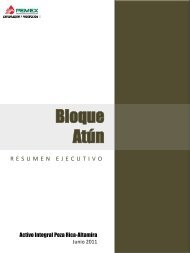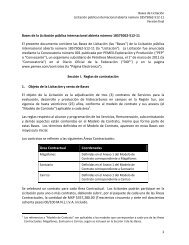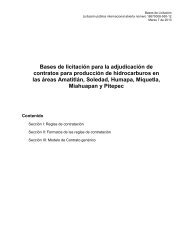Integrated Contract
Integrated Contract
Integrated Contract
Create successful ePaper yourself
Turn your PDF publications into a flip-book with our unique Google optimized e-Paper software.
<strong>Integrated</strong> <strong>Contract</strong><br />
1
Content<br />
<strong>Integrated</strong> <strong>Contract</strong><br />
Introduction ............................................................................................................................... 3<br />
Basin Description ...................................................................................................................... 5<br />
Main Features ........................................................................................................................... 9<br />
History of Exploration and Development ........................................................................ 15<br />
Production by Field and Reserves .................................................................................... 18<br />
Infrastructure and Hydrocarbons Handling ................................................................... 19<br />
Drilling History .......................................................................................................................... 21<br />
2
Introduction<br />
The Miahuapan block is located in the Northwest part of the “Activo Integral Aceite<br />
Terciario del Golfo” surface, covering an area of 128 Km 2 ; it is 20 Km NW of Poza Rica,<br />
Veracruz.<br />
Location of Block Miahuapan<br />
Geologically, it is located in the South of the Tampico - Misantla basin. The principal field<br />
in this area is Miahuapan, which was discovered in 1948; gas and oil shows were observed<br />
in the formation Tamabra, in the well Miahuapan-5 with 2,326m depth.<br />
In this block 54 wells has been drilled, 16 are close, 27 plugged and 11 open. Maximum<br />
production was 1,080 bpd oil with 10 open wells in June, 1976; now (30/06/12)<br />
production is 348 bpd oil, its cumulative production is 42.256 Mbls oil and 5.7MMpc gas.<br />
Oil type is light crude, with a density of 33° API the bottom pressure measured recently in<br />
the well Jiliapa-71 varies between 78 and 150 Kg/cm 2 . The existing production system in<br />
the area is mechanical pump. Average depths of the deposits are 1,900 in Tertiary and<br />
2,380m for Mesozoic.<br />
During drilling of the exploratory wells in the Mesozoic formations: Tamabra, Tamaulipas<br />
Superior, Tamaulipas Inferior, Pimienta y Tamán, light to moderate gas shows occurred; in<br />
the channel samples and cores, oil impregnations were observed.<br />
3
By PVT analysis of different Wells from the formations mentioned, from the Paleocanal<br />
de Chicontepec area, the following information is obtained:<br />
• Coyula-1 Well (located southwest at 8.5 Km from area):<br />
Formation Tamaulipas Superior: 42.2 °API Oil, gas solubility at initial pressure relationship<br />
(Rsi) of 221.60 m 3 /m 3 , Oil Volume Factor (Bo) 1.6629 m 3 /m 3 and a saturation pressure (Pb)<br />
de 217.00 Kg/cm 2 .<br />
• Presidente Miguel Alemán-772 Well (located southeast at 31 Km from area):<br />
Formation Tamaulipas Inferior: 35.7 °API Oil, gas solubility at initial pressure relationship<br />
(Rsi) of 179.50 m 3 /m 3 , Oil Volume Factor (Bo) de 1.6270 m 3 /m 3 and a saturation pressure<br />
(Pb) de 215.20 Kg/cm 2 .<br />
• Caviar-1 Well (located northeast at 160 Km from area):<br />
Formation Pimienta: 15.74 °API Oil, gas solubility at initial pressure relationship (Rsi) of<br />
33.28 m 3 /m 3 , Oil Volume Factor (Bo) de 1.1659 m 3 /m 3 and a saturation pressure (Pb) de<br />
106.16 Kg/cm 2 .<br />
• Furbero-106 Well (located southeast at 25 Km from area):<br />
Formation Tamán: 37.11 °API Oil, gas solubility at initial pressure relationship (Rsi) of<br />
179.60 m 3 /m 3 , Oil Volume Factor (Bo) of 1.8138 m 3 /m 3 and a saturation pressure (Pb) of<br />
175.10 Kg/cm 2 .<br />
• Jiliapa-71 Well (located north at 4.5 Km from area):<br />
Formation Tamabra: 34.5 °API Oil, gas solubility at initial pressure relationship (Rsi) of<br />
120.00 m 3 /m 3 , Oil Volume Factor (Bo) de 1.4234 m 3 /m 3 and a saturation pressure (Pb) de<br />
161.00 Kg/cm 2 .<br />
4
Basin Description<br />
<strong>Integrated</strong> <strong>Contract</strong><br />
The Tampico - Misantla basin is located in Eastern Mexico and it spans from Southern<br />
Tamaulipas to the central part of the State of Veracruz, along with a small part of the east<br />
side of the States of San Luis Potosí, Hidalgo and North of Puebla, down to the 200-m<br />
isobaths of the Gulf of Mexico's continental shelf.<br />
Location of Tampico – Misantla Basin.<br />
The crystalline basement is formed by igneous and metamorphic rock, their ages ranging<br />
from Permian to the middle Jurassic. In the sedimentary column of the Tampico-Misantla<br />
province, the following tectono-sequences are identified:<br />
5
First tectono-sequence (Synrift). Started in the Triassic (250Ma), with the deposition of<br />
continental clasts from alluvial and fluvial environment with some lava flowed from the<br />
Huizachal formation, from the late Triassic age (Noriense-Retiense), over crystalline and<br />
metamorphic basements, later the Huayacocotla formation from the Lower Jurassic<br />
(Hettangiano-Pliensbachiano) was deposited, and it is a sandstones and shale sequence,<br />
from transgressive oceans. By the middle Jurassic, continental conditions were restored,<br />
with Clasts from the Cahuasas formation being deposited, by the end of this period, a new<br />
marine transgression commenced, and favored the deposition of oolithic limestone for<br />
the Huehuetepec formation (Bathonian), and sandy limestone with bioclasts and ooliths<br />
for the Tepexic formation (Callovian), which were overlain by calcareous and<br />
carbonaceous shale with plenty of oGORnic matter, from the Santiago formation<br />
(Oxfordian), deposited on constrained, low-energy seas; as the marine transgression<br />
moved forward, carbonate ramps developed around the basement highs - inside and on<br />
the edge of the former, sandy-clayey limestone and oolithic limestone from the San Pedro<br />
and San Andrés formations were deposited, (Kimmeridgian), respectively, and their lateral<br />
equivalents toward deeper waters, namely, the clayey limestones with scarce bioclasts<br />
and oolites (Chipoco formation) and basin black clayey limestones (Tamán formation).<br />
The transgressive sea conditions continued so that during the Tithonian-Portlandian, a<br />
maximum flooding surface would occur, with most of the basement highs being left in<br />
underwater conditions. During that time, clayey-carbonaceous limestones were<br />
deposited, (rich in oGORnic matter) from the Pimienta formation, from a relatively-deep-<br />
water environment, which is present throughout the region and only in the parts<br />
emerging from the basement, which were under coastal and/or shoreline conditions; La<br />
Casita formation was deposited, which is constituted by glauconitic sandstones.<br />
Passive Margin Tectono-sequence. The marine transgression carried on and ultimately<br />
flooded all of the basement highs, it deposited on the internal parts, limestones and<br />
dolomites, while on the edges, the oGORnic-reefal growths development commenced. At<br />
the same time, and due to the thermal subsidence, the lower areas deepened, giving rise<br />
to deep sea basins, where the three members of the Tamaulipas Inferior formation were<br />
deposited (calcarenithic member, bentonitic member and creamy limestone member)<br />
corresponding to the Berriasian-Barremian age. During the Aptian stage, the Otates<br />
horizon formation deposition occurred, which is considered to be a condensed sequence.<br />
During the Albian, along the entire Tuxpan platform a reef edge, roughly 1400 m thick,<br />
which gave rise to lagoon facies on the inside of the platform, whereas for the reef front,<br />
the Tamabra formation, featuring proximal, mean and distal slope facies, developed due<br />
6
to the reefal denudation, and changes facies with the chalky limestone Tamaulipas<br />
Superior formation.<br />
By the end of the Cenomanian, the platform remained under subaerial conditions by a<br />
regressive marine pulse, which was followed by a new transgressive event allowing the<br />
deposition both in lagoon facies and in the mean, distal slope and basin of the Turonian<br />
Agua Nueva (black clayey limestones with black shales interbeddings), Coniacian-<br />
Santonian San Felipe (greenish-grey clayey limestone with abundant olive green bentonite<br />
interbeddings) and Campanian-Maastrichtian Méndez (clayey limestones and green/red<br />
marls) formations; the period of this tectono-sequence ended with the deposition of the<br />
last formation.<br />
Eventos<br />
Tectónicos<br />
Ambientes<br />
sedimentarios<br />
Geologic column for the Tampico-Misantla basin with reservoir rock, source rock<br />
(unconventional reservoirs), tectonic events and sedimentary environments.<br />
The foreland basin tectono-sequence is characterized by the onset of the Sierra Madre<br />
Oriental's (SMO) uplift, which gave rise to a greater contribution of terrigenous material<br />
7
sediments; these marine cenozoic depositions were originally defined as Tampico-Misantla<br />
Basin by López-Ramos (1956).<br />
The ongoing uplift of the SMO left very narrow coastal plains and continental shelves,<br />
hence the coastal systems would go from a prodelta to a slope, and where the transport of<br />
sediments by means of turbidity currents prevailed, there would be flow of debris and<br />
landslides, which would produce deposition of submarine fans at the bottom of the<br />
seafloor (basin), overlapping each other and generating submarine erosion during their<br />
development.<br />
By the end of the Cenozoic, deltaic environments prevailed.<br />
Tuxpan<br />
Poza Rica<br />
Tecolutla<br />
Tertiary Sedimentary model (Paleogene and Neogene). Note that delta environments<br />
were deposited above the Chicontepec formation<br />
8
Main Features<br />
<strong>Integrated</strong> <strong>Contract</strong><br />
The main producing formation of this block is formed by Mesozoic formations; cumulate<br />
production for this area is 3,400 mbls, while in Chicontepec there’s a cumulate production of<br />
42.25mbls. The producing formations are Tamabra, Tamaulipas Superior, Tamaulipas Inferior,<br />
and Tamán from Cretaceous, Medio, Inferior and Jurassic Superior, respectively.<br />
The reservoirs in this area are located in combined, structural (anticlines with subtle dips<br />
with four-direction closure) and stratigraphic traps.<br />
This block has 51 wells from Mesozoic, 29 of them have production records from that<br />
reservoir; 26 of them belong to Tamabra with a production range between 25 and 673 bpd,<br />
one well in Tamaulipas Superior with 88 bpd, one in Tamaulipas Inferior - Pimienta with 1,849<br />
bpd and one well in Tamán with 195 bpd.<br />
Some examples of producing wells in Mesozoic are: Centurión-1 from Tamabra, Marques-1<br />
from Tamaulipas Superior, Zapotalillo-2 from Tamaulipas Inferior-Pimienta and Papatlarillo-102<br />
from Tamán. 29 wells from Mezosoic show oil impregnation both in cores and cuttings from<br />
San Felipe, Tamabra, Tamaulipas Superior, Tamaulipas Inferior, Pimienta and Tamán<br />
formations, there are also 11 wells which showed gas while drilling in the Brecha, Méndez,<br />
Agua Nueva, Tamabra, Tamaulipas Superior, Tamaulipas Inferior and Tamán formations.<br />
In the Centurión-1 well, no oil or gas shows were detected while drilling, 2 cores were cut in<br />
Tamabra formation with poor oil impregnation. For Tamabra formation, poor viscosity oil and<br />
good light oil impregnation was observed in the cuttings.<br />
Two production tests were conducted in the Tamabra formation, the first test in the 2267-2277<br />
m interval, it exhibited no flow, performed a survey, displacing stained water (95-100% water),<br />
the test concludes and the interval is plugged; the second production test was conducted in the<br />
2179-2189 m interval, performed acid treatment, well is open and displacing oil and gas with<br />
little water, with a production of 673 bpd oil, 1.2% water and GOR: 99 m 3 /m 3 .<br />
In the Marques-1 well, gas shows were observed in the Agua Nueva, Tamabra, Tamaulipas<br />
Superior and Tamaulipas Inferior formations, decreasing the mud density from a range of 1.47<br />
to 0.89 gr/cc in a period from 15 to 90 minutes. One core was cut from the Tamaulipas Inferior<br />
9
formation, with poor oil impregnation in the stratigraphic plains. Light oil impregnation was<br />
found in the cuttings from San Felipe and Tamabra formations and light oil impregnation and<br />
asphalt were found in the Tamaulipas Inferior formation.<br />
In the well Zapotalillo-2, no oil or gas shows were detected while drilling. Two cores were cut<br />
in the formation Tamabra with little oil stains and a few traces of oil. fractures filled with<br />
asphalt, viscous oil and black residual oil were observed in the cuttings from Tamabra,<br />
Tamaulipas Superior, Inferior y Pimienta formations.<br />
Two open-hole tests were made in with acid treatment in the Tamabra formation (1),<br />
recovering gasified mud with traces of oil and the other one in the Inferior-Pimienta formation<br />
(1), recovering oil, gas and little water, resulting in a production of 1,849 bpd oil, water 0.1%,<br />
gas 1.9 mmpcpd, and GOR: 186 m 3 /m 3 .<br />
Two production tests with acid treatment were conducted in the Tamaulipas Superior and in<br />
Tamabra formations, flowing 100% water in the first one and flowing water with oil traces in<br />
the second one.<br />
In the well Papatlarillo-102, strong gas shows were observed while drilling in the Tamán<br />
formation. Five cores were cut, in the formation Tamabra (3) with regular oil impregnation and<br />
in the formation Tamaulipas Superior (1) and Tamán (1) with poor to regular oil impregnation.,<br />
oil impregnation was observed in the cuttings from fracture plains in the Tamabra and<br />
Tamaulipas Inferior formations.<br />
Three production test were conducted, the first one in the 2950-3000 m and 2935-2945 m<br />
intervals in the Tamán formation, they were treated with acid and nitrogen, performed a<br />
survey and resulted in oil, gas and little water (8.6%); the interval was plugged; the second<br />
production test was made in the interval 2290-2300 m from formation Tamabra, with<br />
pneumatic pump flowing water stained with oil, the interval was plugged, finally the third<br />
production test was in the 2209-2230 m interval from Tamabra formation, it was treated with<br />
acid amd pneumatic pumping, flowing water with traces of oil, the interval was plugged.<br />
Below there are some comments about the events occurring during drilling in the<br />
Chicontepec formation rocks:<br />
In this block, there are 54 wells; light to moderate gas shows in 22 wells were reported in the<br />
Palma Real Inferior, Tantoyuca, Guayabal, Chicontepec Superior, Medio, Inferior and Velasco<br />
10
Basal formations. Cores and cuttings in 19 wells showed oil impregnations in the Guayabal,<br />
Chicontepec Superior, Medio, Inferior and Velasco Basal formations .<br />
Some producer wells from Tertiary are: Muahuapan-6A, Centurión-3 and Blenda 1 from<br />
Chicontepec Medio Formation.<br />
In the Miahuapan-6A well, gas shows were observed while drilling in the Palma Real Inferior<br />
and Tantoyuca formations, lowering the mud density from 1.8 to 1.0 gr/cc and from 1.26 to<br />
1.16 gr/cc. Light oil impregnation in cores and cuttings were observed in the Chicontepec<br />
Superior and Medi formations o. One production test was conducted in the Chicontepec<br />
Medio formation, in the interval 1445-1460 m, hydraulic fracturing was performed, with a<br />
production of 176 bpd oil, 0% water and GOR: 100 m 3 /m 3 .<br />
In the Blenda-1 well, no gas shows were observed while drilling in the Tertiary. Light and<br />
heavy oil impregnations were observed in the Chicontepec Superior (Gilsonite tracks), Medio<br />
and Inferior formations.<br />
One production test was conducted in the Chicontepec Medio formation, in the interval 1645-<br />
1660 m, hydraulic fracturing was performed, with a production of 31 bpd oil, 0% water and<br />
GOR: 100 m 3 /m 3 .<br />
Centurion-3 Well, gas shows were observed while drilling the Chicontepec Medio and Velazco<br />
Basal formations, lowering the mud density from 1.34 to 1.08 gr/cc. Light oil impregnation in<br />
cores and cuttings in Aragón and Chicontepec Medio formations. One production test was<br />
conducted in the Chicontepec Medio formation, in the interval 1543-1583 m, hydraulic<br />
fracturing was performed, whit a production of 6 bpd oil, 0% water and GOR: 80 m 3 /m 3 .<br />
11
Structural correlation sections were produced with geophysical logs, and the distinctive<br />
seismic events for the Mesozoic formations were correlated with the seismic information.<br />
The figure shown below is a correlation section with a NW to SE orientation, notice the<br />
structural correlation between the Zapotalillo-1, Independencia-3, Zapotalillo-12, Zapotalillo-<br />
18, Tejada-14, Tejada-61 and Huizotate-10, notice the good development of the producing<br />
sands of the Chicontepec formation. The well Independencia-3 reached the Upper Jurassic<br />
formations, where the hydrocarbon source rocks are, and which are currently considered<br />
as unconventional reservoirs, also known as oil shale.<br />
Terciar<br />
io<br />
Zapotalillo-1 Independencia-3 Zapotalillo-12 Zapotalillo-18 Tejada-14 Tejada-61 Huizotate-10<br />
NW<br />
Cretácico<br />
Jurásico<br />
SE<br />
Sección II<br />
NW structural cross section with well logs. Notice the presence of Jurassic rocks in the<br />
subsurface of the studied area<br />
SE<br />
12
The following figure shows the same section with seismic information, the thickness from<br />
Mesozoic can be observed, and evidencing the developed Upper Jurassic formations.<br />
ZAPOT-1 INDEP-3 ZAPOT-18<br />
BLOQUE MIHUAPAM<br />
SECCION II<br />
ZAPOTALILLO-18<br />
ZAPOTALILLO-12<br />
ZAPOTALILLO-1<br />
TEJADA-61<br />
TEJADA-14<br />
INDEPENDENCIA-3<br />
HUIZOTATE-10<br />
Seismic cross section correlation between the Zapotalillo-1, Independencia-3 and<br />
Zapotalillo-18 wells, the presence of Jurassic source rocks can be observed.<br />
The Miahuapan block is located in the center west side of the Chicontepec paleochannel,<br />
The 3D seismic data available covers 100% of the area, contained in the seismic cube from<br />
Miquetla-Miahuapan and Furbero, processed on Abril 2012 and the seismic cube Cohuca<br />
located in the south side of the block. According to the seismic files, the tree cubes feature<br />
migration pre-stacking time migration, with good quality and optimal vertical resolution.<br />
In addition, 88km of bidimensional (2D) seismic data is available, segments of 56 seismic<br />
lines inside the Miahuapan block.<br />
N<br />
13
The Miahuapan block features 100% of 3D seismic information with the Miquetla,<br />
Miahuapan, Cohuca and Furbero prospects.<br />
14
History of Exploration and Development<br />
The discovery of the fields belongs to the Miahuapan block, in the year of 1948, upon<br />
drilling of the well Miahuapan-5, in 1957 the well Zapotalillo-2 was drilled, with<br />
commercial oil production at an initial rate of 1,849 bpd, with 0% water and 186 m 3 /m 3 of<br />
GOR from Tamaulipas Inferior-Pimienta formation; then in August 1961, well Zapotalillo-3<br />
was completed with a rate of 157 bpd, 0% water and GOR 88 m 3 /m 3 from Tamabra<br />
formation.<br />
The maximum production rate reached was 1,080 bpd oil in June, 1976 from Tamabra<br />
formation; now (30-06-2012) production is 348 bpd oil.<br />
The saturation pressure is 156 Kg/cm 2 (data from PVT of Esfena-1 well, close to the area)<br />
and the reservoir pressure is between 78 and 150 Kg/cm 2 (2,200 mv).<br />
In 2010, operation and maintenance operations were resumed, reactivating wells with<br />
minor repairs in the Coyotes and Horcones fields, which are on the East of this Block; it is<br />
worth mentioning that the average rates prior to reactivation (April 2010) of wells was 20<br />
bpd, of 79 wells in operation, with a monthly average of 1750 bpd and currently (July<br />
2012) the average rate is 30 bpd with 110 wells in operation and an average monthly<br />
production of 3300 bpd.<br />
Drilling activities resumed in 2011 and 2012; three horizontal wells were drilled, and to<br />
this day, two have been completed: Coyotes 423D and Coyotes 276D, both completed<br />
with multifraccing (five) and the initial rate for the former was 400 bpd net oil @ 37 °API<br />
and 0.471 mmmpcd with 30% water cut, which dropped to 15%; the initial rate for the<br />
latter was 318 bpd of oil @ 28° API and 0.093 mmmpcd of gas and and 35% water cut; it is<br />
still undergoing cleaning operations, hence the water cut is expected to drop as in the first<br />
well.<br />
15
Structural seismic section for Coyotes 423D well with horizontal trajectory.<br />
Coyotes 423 wellbore schematic and geophysical log with the surveyed interval in which<br />
five fractures were performed.<br />
16<br />
Geométricos<br />
RESU RE<br />
Geométrico Geométric<br />
Longitud Total<br />
Longitud tota to<br />
Xf<br />
Altura (H)<br />
Xf Xf<br />
Altura (H) (H<br />
Network<br />
Network<br />
Dirección<br />
Dirección<br />
Arena Otaw Ota<br />
20/40<br />
Arena Ottawa 20/40<br />
Fluido Fractu Frac<br />
Fluido de Fractura
<strong>Integrated</strong> <strong>Contract</strong><br />
Currently, Petróleos Mexicanos has initiated an exploration campaign for the assessment<br />
of geological formations considered to be source rocks, i.e., shale oil, by means of<br />
horizontal wells drilling; the drilling of one exploration well 6.3 km North of this block is<br />
under consideration, its main objective being the Upper Jurassic's Pimienta formation.<br />
0<br />
500<br />
1000<br />
1500<br />
2000<br />
2500<br />
3000<br />
3500<br />
NW<br />
KS Mendez<br />
KS SF<br />
KS ANva<br />
KM Tam Sup<br />
KI Tam Inf<br />
JS Tithoniano<br />
JS Kimmeridgiano<br />
Configuración<br />
estructural cima Fm.<br />
Pimienta (m)<br />
Exploration location for the assessment of the Pimienta formation from Upper Jurassic<br />
SE<br />
17
Production by Field and Reserves<br />
The commercial exploitation of oil in this block commenced in 1976 and the production is<br />
associated to field Tejada, which produces from Tamabra formation.<br />
Gastos de aceite, agua (b/d)<br />
1,200<br />
1,000<br />
800<br />
600<br />
400<br />
200<br />
0<br />
01/76<br />
11/76<br />
09/77<br />
07/78<br />
05/79<br />
03/80<br />
01/81<br />
11/81<br />
09/82<br />
07/83<br />
05/84<br />
03/85<br />
01/86<br />
11/86<br />
09/87<br />
07/88<br />
05/89<br />
03/90<br />
01/91<br />
11/91<br />
09/92<br />
07/93<br />
05/94<br />
03/95<br />
01/96<br />
11/96<br />
09/97<br />
07/98<br />
05/99<br />
03/00<br />
01/01<br />
11/01<br />
09/02<br />
07/03<br />
05/04<br />
03/05<br />
01/06<br />
11/06<br />
09/07<br />
07/08<br />
05/09<br />
03/10<br />
01/11<br />
11/11<br />
Production history for Miahuapan block<br />
The original oil in place for the the Miahuapan block is 747.573 MMbls oil and 297.656<br />
MMMpc of gas; with a recovery factor of 13.56 % for oil and 54.69 % for gas, original oil in<br />
place is 101.392 MMbls oil and 295.529 MMMpc gas. The accumulative production is<br />
42.256Mbls oil and 5.72MMpc gas, for remaining reserves of 2P are estimated in 101.35<br />
MMbls of oil and 295.524MMMpc of gas.<br />
Área<br />
desarrollada<br />
por campo<br />
(Km 2 )<br />
Aceite<br />
(MMbl)<br />
Volumen<br />
original<br />
Gas<br />
(MMMpc)<br />
Aceite (Bd) Agua (Bd) Gas (mpc/d)<br />
Aceite<br />
(%)<br />
Factores de<br />
recuperación<br />
Original oil in place, production and remaining reserves for Miahuapan block<br />
Gas<br />
(%)<br />
Aceite<br />
(Mbl)<br />
Producción<br />
acumulada<br />
Gas<br />
(MMpc)<br />
1,400<br />
1,200<br />
1,000<br />
800<br />
600<br />
400<br />
200<br />
Reservas<br />
remanentes 2P<br />
Aceite<br />
(MMbl)<br />
0<br />
Gas<br />
(MMMpc)<br />
128 747.573 297.656 13.56 54.69 42.256 5.72 101.35 295.524<br />
Gastos de gas (mpc/d)<br />
18
Infrastructure and Hydrocarbons Handling<br />
Infrastructure of block Miahuapan<br />
<strong>Integrated</strong> <strong>Contract</strong><br />
The Miahuapan block has a current (30-06-2012) gross production of 618 bpd, which are<br />
transported by tanker trucks to the Tejada Separation Battery (BS).<br />
Current production handling in Miahuapan block<br />
19
The Miahuapan block has the following pipelines:<br />
Origen Destino<br />
Roads within the Miahuapan block<br />
Diám<br />
(pg)<br />
Líneas de Descarga<br />
Long<br />
(km)<br />
Tubería<br />
Año de<br />
Construcció<br />
n<br />
Estado<br />
TEJADA 1 BS TEJADA 4 0.05 LDD S/I Operativa<br />
TEJADA 2 BS TEJADA 4 0.3 LDD S/I Operativa<br />
TEJADA 3 BS TEJADA 4 0.3 LDD S/I Operativa<br />
TEJADA-4 BS TEJADA 4 0.8 LDD S/I Operativa<br />
TEJADA-6 BS TEJADA 4 0.8 LDD S/I Operativa<br />
TEJADA-11 BS TEJADA 4 0.7 LDD S/I Operativa<br />
TEJADA-12 BS TEJADA 4 0.7 LDD S/I Operativa<br />
TEJADA-22 BS TEJADA 4 0.3 LDD S/I Operativa<br />
TEJADA-24 BS TEJADA 4 0.3 LDD S/I Operativa<br />
TEJADA-23 BS TEJADA 4 0.5 LDD S/I Operativa<br />
TEJADA-31 BS TEJADA 4 0.9 LDD S/I Operativa<br />
TEJADA-43 BS TEJADA 4 0.5 LDD S/I Operativa<br />
TEJADA-52 BS TEJADA 4 1.5 LDD S/I Operativa<br />
TEJADA-63 BS TEJADA 4 1.3 LDD S/I Operativa<br />
Road map (roads and unpaved roads) villages, well pads and oil facilities<br />
20
Drilling History<br />
Drill parameters<br />
Deep: 2,200 meters developed<br />
Deviations: 0° (verticals) and directional in Tejada<br />
Densidad de lodos<br />
First stage: 1.20 gr/cm³, water base mud<br />
Second stage: 1.30 gr/cm³, bentonite mud<br />
Third stage: 1.45 gr/cm³; inverse emulsion mud<br />
Objective: Tamabra<br />
<strong>Integrated</strong> <strong>Contract</strong><br />
Difficulties during drilling<br />
Surface stage<br />
Hydration of clays, circulation losses, drag during lowering of casings, borehole instability<br />
and shallow Gas and/or Water flows.<br />
Intermediate stage.<br />
Reactive shale interbeddings, pipes getting stuck and possible fluid loss, high penetration<br />
speeds, possible increases in equivalent circulating density (DEC, in Spanish) due to<br />
concentration of cuttings in the annulus and increases in the number of jammings and<br />
circulation losses.<br />
Production stage<br />
Packing, resistance and drag, presence of formation gas, circulation losses, jammings due<br />
to differential pressure, bit balling, accumulation of slag in the curved section.<br />
Drill practices<br />
The objective of this section is to review common drilling practices used in the<br />
development of this reservoir; they are listed as a reference and not as a proposed<br />
application of methodology and technology by AIATG.<br />
Most of the fixes for the casing pipe (TR) in this area correspond to a design with a 9 5/8”<br />
conductor casing, which is intended for the installation of surface tie-ins and is cemented<br />
down to around 200 and 400 m. The production TR is 6 5/8” it is cemented at 2,200 and<br />
2,300m.<br />
21
he first stages are at normal pressure, and are drilled with water-based mud and with<br />
control densities ranging between 1.20 a 1.45 gr/cm³; in the case of abnormal densities,<br />
this is due to the shale stability control and not because it is required by the pressure<br />
gradient. The exploitation stage is drilled with water-based fluid (sodium brine), capable<br />
of increasing its viscosity in case of any contingency; it is also friendly to the production<br />
formation, and the control density can be adjusted.<br />
The Christmas tree dimensions are 9 5/8” x 6 5/8” x 2 7/8” 5,000 lb/pg²; no problems<br />
were encountered during the drilling process.<br />
22
***<br />
23














